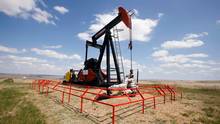Wary oil patch gears down
 The spending spree in Canada’s fast-growing oil sands is slowing as some of the country’s largest energy companies trim capital budgets and question the fate of some of their most important projects.
The spending spree in Canada’s fast-growing oil sands is slowing as some of the country’s largest energy companies trim capital budgets and question the fate of some of their most important projects.Money continues to pour into the oil sands, where $1-billion is spent every two and a half weeks in the rush to add millions of barrels of capacity. But that spending has been under increased scrutiny.
The latest blow comes from Canadian Natural Resources Ltd., which said Thursday it has cut capital spending this year by $680-million or 10 per cent – much of that from its Horizon oil sands project. The company is attempting to hold the line on spending, while acknowledging that new projects will need oil prices of nearly $80 (U.S.) a barrel – not far from current levels – to turn a minimum acceptable profit.
The move comes amid what’s being called a “big rethink” of the oil sands, where costs have risen so high that new projects are increasingly vulnerable to crude prices at the same time as environmental pressures place question marks over the pipelines intended to take new barrels to market.
The CNRL spending pare-back comes a little more than two weeks after Suncor Energy Inc. abandoned a plan to reach production of a million barrels a day by 2020.
Suncor said it would instead apply “rigorous scrutiny” to three of its most important new oil sands projects, worth more than $20-billion (Canadian).
The new uncertainty casts a shadow over a rosy new industry forecast, released in June by the Canadian Association of Petroleum Producers, that projected oil sands output to more than double by 2021, adding just over two million barrels a day in a decade.
At the same time, it points to the upheaval facing an industry that has seen many of its fundamental assumptions shaken in recent years. Not only have new pipeline plans been the subject of massive public scrutiny, but a sudden rise in production of light oil spurred by technology have made clear that the oil sands are no longer the only – or best – bet for companies seeking to pump new barrels.
In Alberta alone, new fracking techniques have in the past two years brought 175,000 barrels a day of unexpected light oil production – the equivalent of two large oil sands facilities, notes Peter Tertzakian, chief energy economist with ARC Financial Corp.
A half century of certainty over the source and destination of hydrocarbons is suddenly in question, and the “oil sands was more of a compelling story even a year ago than it is today. Now if you’ve got a billion dollars to spend, you’ve go to be thinking about all these threats and new opportunities and how you’re going to spend your money,” Mr. Tertzakian said. It is “a big rethink of capital allocation.”
Part of it is related to the sheer difficulty of turning a profit in the oil sands. CNRL, for example has set $100,000 per flowing barrel, a standard metric showing the cost of producing one daily barrel of crude, as the de facto ceiling for the cost of its Horizon expansion.
“Above $100,000 a flowing barrel, you start to erode your economics on these projects,” said company president Steve Laut. But even at that level, the company says it needs $80 (U.S.) WTI – the U.S. benchmark oil price, which closed Thursday at $93.50 – “to get a return on capital that we require.”
To hold the line on those costs, CNRL has cut $405-million (Canadian), or 17.5 per cent, from its 2012 spending on Horizon. Roughly 30 per cent of the decrease came from cost savings achieved by, for example, splitting up and re-tendering contracts where bids came in too high. But the remainder came by way of “strategic deferrals” in which the company delayed spending in hopes that it can gain better pricing in the future.
It is a “good thing to get better costs and let the schedule slip,” Mr. Laut said. CNRL has not yet seen completion dates change for the extra 135,000 barrels a day of production it is building at Horizon. But the company is only partway through the project, and is “close to pushing out” its completion dates, Mr. Laut said.
What’s clear, CIBC World Markets Inc. said in a Thursday report, is that the spending uncertainty in the oil sands is cause for concern. Although the cuts won’t affect growth in the next few quarters, they “will push back long-term targets and raise questions regarding project viability,” CIBC said.
You can return to the main Market News page, or press the Back button on your browser.

